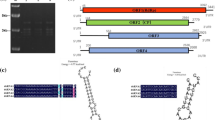Abstract
Beauveria bassiana is a ubiquitous entomopathogen infecting hundreds of insect species. We have determined the genomic organization and the complete nucleotide sequence of a novel virus isolated from the isolate A24 of B. bassiana. Phylogenetic analysis of the polymerase gene reveals that the virus, tentatively named Beauveria bassiana virus 1, belongs to the family Amalgaviridae and represents a distinct lineage of amalgaviruses infecting fungi.


Similar content being viewed by others
References
Nibert ML, Ghabrial SA, Maiss E et al (2014) Taxonomic reorganization of family Partitiviridae and other recent progress in partitivirus research. Virus Res 188C:128–141. doi:10.1016/j.virusres.2014.04.007
Xiao G, Ying S-H, Zheng P et al (2012) Genomic perspectives on the evolution of fungal entomopathogenicity in Beauveria bassiana. Sci Rep 2:483. doi:10.1038/srep00483
Herrero N, Dueñas E, Quesada-Moraga E, Zabalgogeazcoa I (2012) Prevalence and diversity of viruses in the entomopathogenic fungus Beauveria bassiana. Appl Environ Microbiol 78:8523–8530. doi:10.1128/AEM.01954-12
Yie SW, Khalifa ME, Hahn T, Pearson MN (2013) Molecular characterization of a novel victorivirus from the entomopathogenic fungus Beauveria bassiana. Arch Virol 159:1321–1327. doi:10.1007/s00705-013-1938-6
Castillo A, Cottet L, Castro M, Sepúlveda F (2011) Rapid isolation of mycoviral double-stranded RNA from Botrytis cinerea and Saccharomyces cerevisiae. Virol J 8:38. doi:10.1186/1743-422X-8-38
Darissa O, Willingmann P, Adam G (2010) Optimized approaches for the sequence determination of double-stranded RNA templates. J Virol Methods 169:397–403. doi:10.1016/j.jviromet.2010.08.013
White TJ, Bruns T, Lee S, Taylor J (1990) Amplification and direct sequencing of fungal ribosomal RNA genes for phylogenetics. In: Innis MA, Gelfand DH, Sninsky JJ, White TJ (eds) PCR protocols. A guide to methods and applications. Academic Press, New York, pp 315–322
Lin Y, Zhang H, Zhao C et al (2014) The complete genome sequence of a novel mycovirus from Alternaria longipes strain HN28. Arch Virol. doi:10.1007/s00705-014-2218-9
Sabanadzovic S, Abou Ghanem-Sabanadzovic N, Valverde RA (2010) A novel monopartite dsRNA virus from rhododendron. Arch Virol 155:1859–1863. doi:10.1007/s00705-010-0770-5
Sabanadzovic S, Valverde RA, Brown JK et al (2009) Southern tomato virus: the link between the families Totiviridae and Partitiviridae. Virus Res 140:130–137. doi:10.1016/j.virusres.2008.11.018
Liu W, Chen J (2009) A double-stranded RNA as the genome of a potential virus infecting Vicia faba. Virus Genes 39:126–131. doi:10.1007/s11262-009-0362-1
Klootwijk J, Klein I, Zabel P, van Kammen A (1977) Cowpea mosaic virus RNAs have neither m7G pppN … nor mono-, di- or triphosphates at their 5’ ends. Cell 11:73–82
Dereeper A, Guignon V, Blanc G et al (2008) Phylogeny.fr: robust phylogenetic analysis for the non-specialist. Nucleic Acids Res 36:W465–W469. doi:10.1093/nar/gkn180
Guindon S, Dufayard J-F, Lefort V et al (2010) New algorithms and methods to estimate maximum-likelihood phylogenies: assessing the performance of PhyML 3.0. Syst Biol 59:307–321. doi:10.1093/sysbio/syq010
Zhang T, Jiang Y, Dong W (2014) A novel monopartite dsRNA virus isolated from the phytopathogenic fungus Ustilaginoidea virens and ancestrally related to a mitochondria-associated dsRNA in the green alga Bryopsis. Virology 462–463:227–235. doi:10.1016/j.virol.2014.06.003
Kotta-Loizou I, Sipkova J, Coutts RHA (2015) Identification and sequence determination of a novel double-stranded RNA mycovirus from the entomopathogenic fungus Beauveria bassiana. Arch Virol 160:873–875. doi:10.1007/s00705-014-2332-8
Acknowledgments
The authors would like to thank the anonymous reviewers for their valuable comments and suggestions. This work was supported by Postdok_BIOGLOBE (CZ.1.07/2.3.00/30.0032), co-financed by the European Social Fund and the State Budget of the Czech Republic (to I.K and K.P) and project LH-13136 Kontakt II - “Mycovirus-host interactions in diseased isolates of phyto- and entomopathogenic micromycetes” from the Ministry of Education, Youth and Sports of the Czech Republic (to K.P).
Author information
Authors and Affiliations
Corresponding author
Electronic supplementary material
Below is the link to the electronic supplementary material.
Rights and permissions
About this article
Cite this article
Koloniuk, I., Hrabáková, L. & Petrzik, K. Molecular characterization of a novel amalgavirus from the entomopathogenic fungus Beauveria bassiana . Arch Virol 160, 1585–1588 (2015). https://doi.org/10.1007/s00705-015-2416-0
Received:
Accepted:
Published:
Issue Date:
DOI: https://doi.org/10.1007/s00705-015-2416-0




